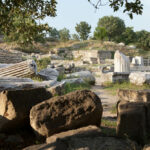Trojan Amphitheater
 The name of the famous amphitheater may have changed over time, but its reputation as one of the most recognizable symbols of the state has never wavered. Home to the University of Alabama for more than a century, Bryant-Denny Stadium is also flanked by two other structures that are just as iconic: The University of Alabama’s ancient Trojan Horse and the popular Tuscaloosa Amphitheater. It is located at 199 McKinley Dr #101, Troy, AL 36081.
The name of the famous amphitheater may have changed over time, but its reputation as one of the most recognizable symbols of the state has never wavered. Home to the University of Alabama for more than a century, Bryant-Denny Stadium is also flanked by two other structures that are just as iconic: The University of Alabama’s ancient Trojan Horse and the popular Tuscaloosa Amphitheater. It is located at 199 McKinley Dr #101, Troy, AL 36081.
Introduction to an amphitheater: What is an amphitheater?
An amphitheater, also referred to as a Roman amphitheater, is a type of outdoor performance venue. These structures are used for concerts and sporting events, and their unique design allows people to be right on top of the stage while still feeling a sense of privacy. While amphitheaters are typically oval in shape, they can take on many other shapes and sizes depending on their purpose. Some examples of amphitheaters include the Hollywood Bowl in Los Angeles and the Gorge Amphitheatre in Washington. Other types of venues that are similar to amphitheaters include arenas and stadiums.
The History of the Alabama Trojan Horse
The first thing to know about the Alabama Trojan Horse is that it’s not actually a horse. Instead, it’s a replica of a famous artifact from ancient Troy. This equestrian statue, known as the Trojan Horse, was the inspiration for the amphitheater’s namesake. It was constructed in the early 1900s in Troy, Alabama, as part of the celebration of a railroad connecting the city to the rest of the nation. The Trojan Horse replica was commissioned by Troy’s Chamber of Commerce. It was built by the B.F. White Company, a company that regularly constructed large sculptures in the state of Alabama. The replica Trojan Horse was made of wood and metal, and even had an electric lighting system that could be activated by a remote controller.
The History of Tuscaloosa Amphitheater
Built in 1931, the Tuscaloosa Amphitheater is one of the oldest outdoor performing arts venues in the United States. The amphitheater was named after the nearby Tuscaloosa River and was built as a project of the Works Progress Administration, a federal program led by Franklin D. Roosevelt that provided employment for millions during the Great Depression. This was also the same year that Bryant-Denny Stadium opened, giving the University of Alabama a new home for its football team. Tuscaloosa Amphitheater has a capacity of 6,000 people, which is interesting considering that the University of Alabama only has a maximum enrollment of around 50,000.
Conclusion
The Trojan Amphitheater has seen its fair share of renovations over the years, but it’s still one of the most recognizable landmarks in the state. The amphitheater is often the first thing people think of when they think of Alabama. And it’s easy to see why. The amphitheater is an incredible place to see a concert or see a play, and it’s also a great place to visit if you’re interested in Alabama’s history. And with its rich tradition of Greek drama, it’s easy to see why the amphitheater is also a part of the state’s cultural tradition.
Driving Directions To Luther's Lock-it Self-Storage From This POI
Driving Directions To The FIRST POI